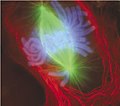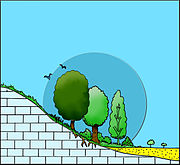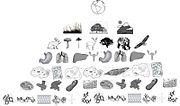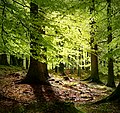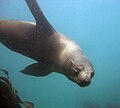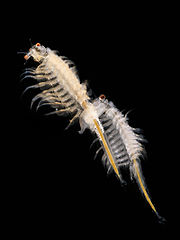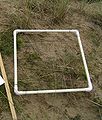Biological Investigation
| “ | The great tragedy of science - the slaying of a beautiful hypothesis by an ugly fact - Thomas Huxley | ” |
|
|
|
A free content video streamed from Vimeo
Avoid deletion: Upload a free format version of this video to the Commons |
Contents
Introduction
Living systems are organised and regulate themselves at the cell, organism, and ecosystem levels. Each of these dynamic systems maintains stability in response to a changing environment and their responses in turn impact on the environment.
For something to be classified as living it must show the seven characteristics of life:
|
|
|
|
A free content video streamed from Vimeo
Avoid deletion: Upload a free format version of this video to the Commons |
Cant remember this stuff? You need to go over it then!
Take a look here for help on the seven characteristic of life, and here for more information on the five kingdoms. Have a go using classification keys here. General cell theory can be reviewed at the cells alive website, biology for kids, or for more detail check out the Learn. Genetics site.
Living Systems
Living systems are organised and regulate themselves at the cell, organism, and ecosystem levels.
At the end of the living systems unit you should be able to:
|
Levels of organisation
Scientists organise life into different levels of organisation. Multicellular organisms are complex, we have big bodies that are capable of performing complex tasks, and exploiting different environments.
Biological organisation breaks down living organisms to different levels, or increasing complexity. This organisation provides a framework for understanding and scientific study.
| Research the topic of 'Biological organisation' and summarise your findings in your own words. You will want to include the terms atom, organ, organ system, organism, species, kingdom, and classification in your summary.
|
Model Ecosystem
By studying different environments, and modelling these we can show an understanding of ecological principles.
| In groups you are going to create, observe, and document your own bottle biology ecosystem models. Instructions are found here. Your group can choose how to document this investigation, perhaps a poster, report, glog, or even add a page to this wiki
You will get a copy of the task sheet from your teacher.
|
Ecosystems can be as small as a puddle or as large as a continent. An ecosystem is a community where lots of different populations of organisms interact with each other, and the other non-living factors in the environment. The biotic (living) and abiotic (non-living) factors constantly affect one another. Ecosystems are dynamic - always changing, adjusting, and being affected.
Energy typically enters the ecosystem through photosynthetic organisms capturing sunlight energy and converting it into glucose, which is then eaten (consumed) by other organisms. Populations inhabit different habitats, and exploit slightly different niches within these habitats to avoid competition.
Different ecosystems can include:
- Forest
- Human
- Urban
- Inland
- Geothermal
- Coastal Marine
- Riparian zone
- River
- Freshwater lake
- Pond
- Cave
- Desert
- Alpine
- Littoral Marine
- Deep sea Marine and many more...
There are many ecosystems found in NZ, and many of them are considered to be very rare.
| How much life is there within one cubic foot?
"In any habitat, on the ground, in the forest canopy, or in the water, your eye is first caught by the big animals—birds, mammals, fish, butterflies. But gradually the smaller inhabitants, far more numerous, begin to eclipse them. There are the insect myriads creeping and buzzing among the weeds, the worms and unnameable creatures that squirm or scuttle for cover when you turn garden soil for planting. There are those annoying ants that swarm out when their nest is accidentally cut open and the pesky beetle grubs exposed at yellowed grass roots. When you flip a rock over, there are even more: You see spiderlings and sundry pale unknowns of diverse form slinking through mats of fungus strands. Tiny beetles hide from the sudden light, and pill bugs curl their bodies into defensive balls. Centipedes and millipedes, the armoured snakes of their size class, squeeze into the nearest crevices and wormholes." Visit this website, read the article, take a look through the image gallery, and watch the videos. Make a list of five new things you learnt, list your five favourite organisms, and pick your favourite habitat and describe WHY you liked it. |
Ecological Principles
- Organisms have an optimal range of different environmental factors within which they are able to live successfully. This determines where they are able to live.
- Organisms have a niche within their habitat. This is when they are active, where and what they feed on. This allows different organisms to survive in the same habitat by reducing competition.
- A habitat is where a population lives, and the niche is the organisms activity within that habitat e.g. when it is active, and what it feeds on.
- A population is a group of individuals from the same species living in one place.
- A community holds many populations in one place.
| In pairs for one ecosystem research the important biotic and abiotic factors affecting populations.
Each pair MUST pick a different ecosystem from anyone else in the class
|
| Present your ecosystem research on a glogster page and paste a link here. You can complete this in pairs, but each pair must find a different ecosystem to investigate and present.
|
Ecosystem management
|
Management of Ecosystems The first step in being able to manage an ecosystem is understanding the important components. This means that information about abiotic and biotic factors must be gathered. Then to manage the living organisms, the natural or abiotic resources must be managed. For instance it is very hard to make a particular type of endangered fish breed, but if you make sure there is unpolluted water, lots of undamaged habitat, and a high amount of food and other important resources the fish is more likely to flourish. Secondly an ecosystem may be managed by keeping the ecosystem free of introduced and non-native species that may predate upon, or compete with native species. |
| Little Barrier Island
|
| Collaborate to present understanding on the management of Little Barrier Island with another wikieducator page attached to this page. |
| Collaborating with other members of the class to contribute to ecosystem management understanding |
Responses
Living systems are organised and regulate themselves at the cell, organism, and ecosystem levels. Each of these dynamic systems maintains stability in response to changing environments.
By the end of the responses unit you should be able to:
|
Scientific research
Scientists develop new ideas through research, and relate current scientific knowledge into work on the interactions of organisms with the environment (in the lab).
Scientific research always follows the same process, as shown above. Ideas must be presented in some form to the scientific community, and/or the public. Most research is written in a scientific journal article, or presented in a scientific poster at conference before being presented to the public. Scientific publications undergo intense peer scrutiny before being able to be published.
The general format of a scientific report is as follows (keeping in mind this is for publication, what YOU need to do is a little less detailed!)
- Title: This includes a very detailed description of the project e.g. "Intermittent access to beer promotes binge-like drinking in adolescent but not adult Wistar rats"
- Abstract: This is a paragraph that summarises the most important parts of the entire report. This is useful for scientists, who can then read the abstract first before deciding if they want to read the entire report.
- Introduction: This provides important background information for the report.
- Aim: The general aim of the research e.g. To find the effect of light intensity on the growth of pine trees.
- Hypothesis: The specific guess at results e.g. As light intensity increases it is hypothesised that the pine tree growth will increase.
- Method: A detailed description of how the research was conducted - in enough detail that you could repeat the experiment after reading it.
- Results: This includes a visual display of results and a written description of significant trends shown.
- Discussion: Explanation of results in a scientific bases, comparison with other related reserarch, and analysis of the validity of the method and results.
- References: A list of references cited during the report.
Other factors to consider in the evaluation of reports, or the planning of your own research are: *Fair testing: Is the experimental method designed in a way that actually tests the aim / hypothesis?
- Control of variables: Are there other factors in the method that may influence the results?
- Range of the independent variable: If you are changing a factor e.g. salinity have you got a valid range - having just freshwater and really salty will not allow you to draw valid conclusions from the data.
- Measurement of the dependant variable: Was this measured accurately?
- Validity of results: Was you method vaild and fair? Did you repeat your research enough so that you have confidence for your results?
| For one plant and one animal in your ecosystem, research how the population studies in the field might be carried out by scientists, and tolerance studies in the lab. For example how would you sample how many, and which position on the rocky shore you would find barnacles, and in the lab investigate barnacle tolerance to water level or salinity?
|
| Integrate the above activities above to show how research on ecology is typically carried out by scientists. You must present your work using some online form e.g. glog. Put the link to your summary on the bottom of your ecosystem wiki page. |
Investigation: Artemia responses
You may want to start your research with some of these websites:
- http://www.fao.org/docrep/003/W3732E/w3732e0m.htm
- http://www.petworld.co.nz/index.php?option=com_content&view=article&id=23&Itemid=26
- http://www.teara.govt.nz/en/salt/3/1
- elmu.umm.ac.id/file.php/1/jurnal/J-a/.../Vol244.Issue1.../3378.pdf
| Plan, and carry out your laboratory research on Artemia. Your teacher will make the task sheet avaialable to you. |
| AS91153: Carry out a practical investigation in a biology context, with guidance, internal, 4 cr. |
Evaluate explanations
As we learnt earlier, peer review is an important part of the scientific process.
| In your groups you need to review each submitted scientific report according to the review task sheet. Once you have done this you must write a paragraph summary that will act as an abstract for the report. |
| As a class you are going to collaborate to produce the '2013 ASHS Journal of Biology Responses'. Each report will be peer reviewed, and have an abstract created. |
Issue: Dairy run-off
Now that you have looked at ecosystems, the scientific process, and the peer review process you are going to examine an issue and apply your understanding to that issue.
Interactions
Organisms responses to changing environments in turn impact the environment.
- HSU Fish Ecology.jpg
Ecology field research
- Transect in forest.jpg
Transect line in a forest - appropriate for sampling on a slope
For the interactions topic you should be able to:
|
Field work
How do scientists study ecology in the field? What different techniques do they use, and how do they know which technique is appropriate for each different organism or environment?
| Contribute to the wiki page that summarises the ecological field study techniques. |
Investigation: Rocky Shore
The ecosystem that we are going to study in the field is the rocky shore. You are going to plan, carry out, and write up a study of an aspect of the ecology of organisms living in this environment.
New Zealand has a relatively large amount of coastline compared to other countries. This coastline can be varied - from cliffs to sandy beaches, estuaries, and rocky shores.
Life on the rocky shore is not easy; with the rise and fall of the tide the animals and plants are exposed to the air, and then covered by water again. Each time the tide goes out it leaves behind a layer of food on the rocks. On its return, the sea is rich with millions of tiny plants and animals (plankton) feeding the larger animals of the rocky shore.
Salinity, water, wave action, competition and predation are all factors affecting survival chances on the rocky shore.
Here's a few websites to start your research:
- National Aquarium of NZ
- National Library
- Otago University produced resources
- Te Ara NZ Encyclopedia
- Seaweek
- Goat Island
| AS91158: Investigate a pattern in an ecological community, with supervision, internal, 4 cr. |
<
Peer review
As we learnt earlier, peer review is an important part of the scientific process.
| In your groups you need to review each submitted scientific report according to the review task sheet. Once you have done this you must write a paragraph summary that will act as an abstract for the report. |
| As a class you are going to collaborate to produce the '2013 ASHS Journal of Biology Responses'. Each report will be peer reviewed, and have an abstract created. |
Issue: Long bay marine reserve
You have examined the tolerance of a sea organism, and studied distribution of populations on the rocky shore. Now you are going to use this knowledge to examine another local area.
| Long bay marine reserve
The Long Bay-Okura Marine Reserve protects a stretch of coastline on the east coast just north of Auckland city. The coast here is typical of that found throughout much of the Waitemata Harbour and inner Hauraki Gulf. It is moderately sheltered, and largely formed of Waitemata sandstones and mudstones. |







